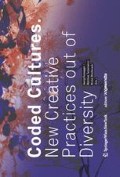Abstract
The relationship between art, science, technology and culture is a complex issue that consists of a network of influences and interactions. Today, media technology is shared as an everyday tool both for work and for fun, by practically everyone including artists, designers, engineers, scientists, businessmen, as well as amateur photographers who upload their works for public viewing and ≫consumers≪ who enjoy viewing artworks or buy designed furniture (or rather, much inexpensive gadgets) online. Works of media art integrate art and technology, often questioning what media technology means to us, but also showing how technology can push the border of art. Tools the artists use and venues where their works are shown—or experienced —are often very different from those in traditional art. Often it is not even clear if a work—a network project with public participation, for example—is to be considered art or not. Still, the definition of media art—although it can never be clear cut-seems to be bound by the traditional Western paradigm of art.
Preview
Unable to display preview. Download preview PDF.
References
Benjamin, W.: The Work of Art in the Age of Mechanical Reproduction. Frankfurt a.M., 1936
Driesche, F.: Gramophone, Film, Typewriter. Berlin: Brinkmann und Bose, 1986; Stanford: Stanford University Press, 1999
Hara, K.: Designing Design. 2nd Ed. Baden: Lars Müller Publishers, 2007 Original Japanese version: Tokyo: Iwamani Publishing, 2003.
Kusahara, M.: ≫They Are Born to Play: Japanese Visual Entertainment from Nintendo to Mobile Phones≪. In: Kluszczynski, R. W. (Ed.): Art Inquiry, Vol. V(XIV): Cyberarts, Cybercultures, Cybersocieties. pp. 111–154. Warsaw: LODZ, 2004
Kusahara, M.: ≫Device Art: A New Approach in Understanding Japanese Contemporary Media Art≪. In: Grau, O.: MediaArtHistories. pp. 277–307. Cambridge, Mass.: MIT Press, 2007
Kusahara, M.: Mitate: Realizing Playfulness, Multiple Viewpoints and Complexity in Device Art. Belfast: ISEA, 2009
Screech, T.: The Lens Within Heart: The Western Scientific Gaze at Popular Imagery in Late Edo Japan. Richmond: Curzon, 1996; Honolulu: University of Hawai’i Press, 2002
Stafford, B.: Devices of Wonder: From the World in a Box to Images on a Screen. Los Angeles: J. Paul Getty Museum, 2001
Tsurumi, K.: Kokishin-to Nihonjin (Curiosity and the Japanese). Tokyo: Kodansha, 1972
Yoshida, M.: ASOBI: The Sensibilities at Play. Hiroshima: Mazda Motor Corporation, 1987
Editor information
Rights and permissions
Copyright information
© 2011 Springer-Verlag/Wien
About this chapter
Cite this chapter
Kusahara, M. (2011). Assembling Art, Design, Technology and Media Culture: The Challenge of Japanese Device Art. In: Russegger, G., Tarasiewicz, M., Wlodkowski, M. (eds) Coded Cultures. Edition Angewandte. Springer, Vienna. https://doi.org/10.1007/978-3-7091-0458-3_6
Download citation
DOI: https://doi.org/10.1007/978-3-7091-0458-3_6
Publisher Name: Springer, Vienna
Print ISBN: 978-3-7091-0457-6
Online ISBN: 978-3-7091-0458-3

